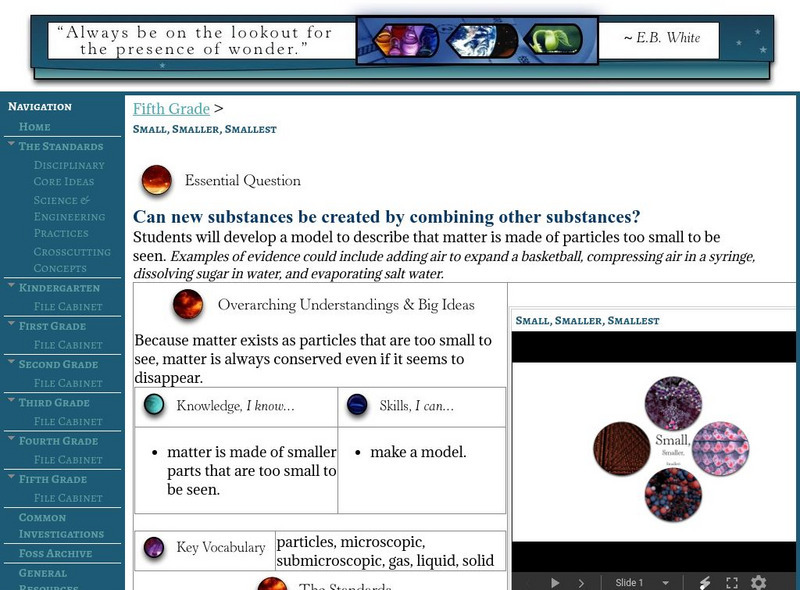Curated OER
The Atoms Family ~ Atomic Math Challenge
Bold boxes present parts of the periodic table, with some of the contents conveniently missing. Beginning chemists fill in the blanks, which may include the atomic number, atomic mass, atomic symbol, or element name. Beneath each box...
Cornell University
Nano Interactions
Tiny particles can provide big learning opportunities! Middle school scientists explore the world of nanoparticles through reading, discussion, and experiment. Collaborative groups first apply nanotechnology to determine water...
Curated OER
Aerogel
Students identify how technology aids scientists in their research. Through discussion, they explain the various ways scientists use Aerogel to aid in their collection of high-speed particles. Through experimentation, students create...
Curated OER
Worksheet 4 - Chemistry 110
A simple worksheet that allows junior chemists to chart the number of subatomic particles for various atoms in the form of a data table. It also requires them to write nuclear symbols for different atoms and isotopes. This would be a...
Biology Junction
Chemistry Crossword
Scholars complete a crossword puzzle in this chemistry activity with 20 questions about chemistry concepts like atoms and chemical reactions.
Curated OER
Development of the Atomic Theory
In this atomic theory worksheet, learners complete a paragraph describing the development of the atomic theory by filling in the blank with 21 terms.
Curated OER
Weathering and Erosion
In this earth science worksheet, students use the clues given at the bottom of the sheet to help them solve the crossword puzzle on weathering and erosion. They identify the various factors that cause erosion in different places.
Curated OER
Introduction to the Periodic Table of Elements
Students explain how the elements are arranged in the periodic table. In this chemistry lesson, students determine the subatomic particles for certain elements. They research the physical and chemical properties of an element they chose.
Curated OER
Understanding: Uncertainty
High schoolers discuss the Heisenberg uncertainty principle and how it applies to the subatomic world. Working in groups, they design a model that would help others to understand the uncertainty principle. Written explanations are...
Curated OER
Sound
Students identify and explain these vocabulary words: vibration, volume, pitch, particles, tuning forks, waves and matter. They explain that sound travels through gas, liquid and solid. They be
Curated OER
Investigating Falling Particles
Young scholars investigate the characteristics of a clay ball. For this particles lesson students examine what happens to a ball of clay when it is dropped from different heights.
Curated OER
Elements and Ions Worksheet
In this elements and ions worksheet, students complete a table given an element, the symbol, or the number of subatomic particles and they must complete the rest of the table. The do the same for five ions. They also write formulas and...
Curated OER
Structure of the Atom
Students identify the location and change of the subatomic particles of an atom. They name the three subatomic particles. Students review what they can recall about subatomic particles. They are given a worksheet on the subatomic...
Curated OER
Determine Soil Particle Size
Students examine various soil samples in groups. Using the samples, they identify the characteristics of them and calculate percolation and infiltration rates. They use this information to discover why some species can survive in one...
Curated OER
Settling Rates of Different Size Particles
Pupils discover how and why the settling rate of particles differs with the size of the particles. Using different soil samples, they calculate the amount of time it takes for a sample to settle in water for up to forty minutes. They...
Curated OER
The Nucleus / Nuclear Reactions and Elementary Particles
Students describe how radioactivity relates to alpha and beta particles. Using their properties, they write a descriptive paper about the gamma rays and alpha and beta particles. They calculate q-values and the half-life of a given...
National Academies of Sciences, Engineering, and Medicine
National Academies Press: Small, Smaller, Smallest
View these slides to better understand that matter is made of smaller parts that are too small to be seen. These slides can be used to meet math, science, and literacy standards.


















